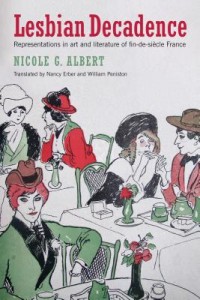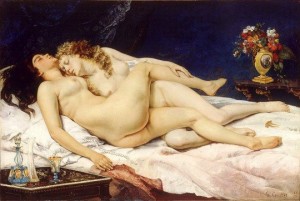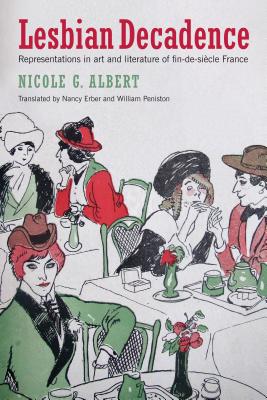 Lesbian Decadence: Representations in Art
Lesbian Decadence: Representations in Art
and Literature of Fin-de-siècle France
by Nicole G. Albert
Translated by Nancy Erber and William Peniston
Harrington Park Press. 380 pages, $40.
NEWLY TRANSLATED from the French, this intriguing inquiry is divided into three parts and twelve information-packed chapters. From the outset, author Nicole G. Albert sets out to show how male writers and artists propagated falsehoods about lesbianism in fin-de-siècle France. She argues that the renewal of interest in Sappho is inseparable from the vogue for antiquity that reached a high point in the 1890s. She shows how, between the mid-19th and early 20th centuries, a veritable cottage industry arose to produce books and pictures dealing with lesbians. Lesbian Decadence is a kind of decadent tour of lesbian Paris according to mostly male writers and illustrators obsessed with what women do with each other in bed.
The mythic Sappho inspired a torrent of writing and painting in Europe: short stories, essays, novels, and steamy visual images that broke new erotic ground. It was Gustave Courbet’s Venus and Psyche that introduced lesbianism to the art world in a painting that depicts a naked young woman asleep on a bed next to a kneeling Venus, whose nudity is only partially hidden from the spectator’s prying eyes. This sensual goddess pulls back the sheets in order to get a better look at her sleeping beauty. And this was not the last time that Courbet’s lesbian subject matter would shock and titillate French society. In 1866 he unveiled The Sleepers, daring to show two naked women intertwined on a bed, neither a goddess nor an allegorical figure. The scene leaves no doubt about the sexual nature of their relationship.

Paris had become a Mecca for women-loving women by 1900. Among those who moved there were Renée Vivienne, Natalie Clifford Barney, Romaine Brooks, Gertrude Stein, and Janet Flanner, to mention a few of the intellectual women who could live a freer life there than almost anywhere else. Albert points out that lesbian adulterers could escape the clutches of the justice system, because the Napoleonic Code tacitly permitted homosexual activity between adults in private.
In January 1895, Pierre Louÿs’ Les Chansons de Bilitis (“The Songs of Bilitis”), a fake scholarly translation, created a sensation. After a falling out with his lover, André Gide, Louÿs dedicated the second edition to Natalie Barney, who was one of the “young ladies of the future” honored by his book.
The literary community christened Barney’s lover, Renée Vivian, as the “new Sappho” because of her translations of Sappho’s work. In 1905, Vivian and Barney were so inspired by Sappho that they rented a villa in the middle of an orchard on the Greek isle of Lesbos. For many decadents, it was an isle of bliss that Gabriele D’Annunzio likened to Olympus. Even so, turn-of-the-century literature continued to emphasize the harm caused by lesbianism. A torrent of short stories appeared in newspapers and magazines with titles such as “Girls’ First Communion,” “Lesbian Springtime,” “The Daughters of Lesbos,” and “A Funeral in Lesbos.” All these writings show how ill-at-ease French society was with such women.
In her landmark study, Albert has reassembled a neglected history. She paints a portrait of a male-dominated culture and a society terrified of women who refused to play out their traditional roles of wife and mother. On the other hand, all these erotic titillations, however unsettling, stimulated voyeuristic fantasies in both sexes while simultaneously reinforcing men’s fears that, in a world of sexual equality, they would be deprived of women, sex, love, and friendship.
________________________________________________________
Cassandra Langer is the author of Romaine Brooks: A Life (2015).






